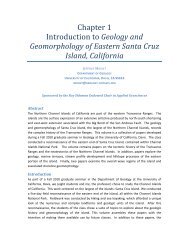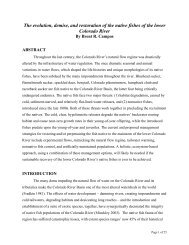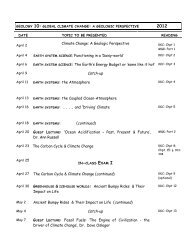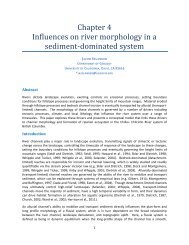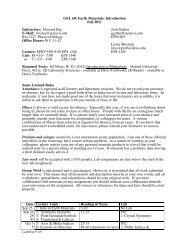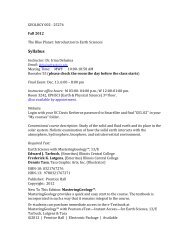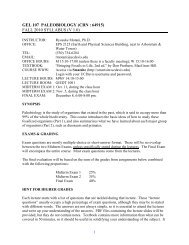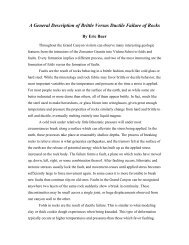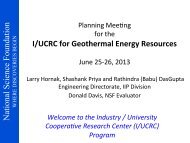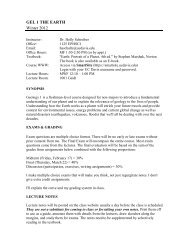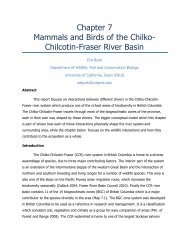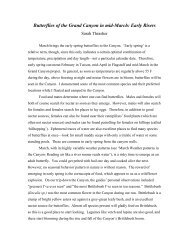Functional Process Zones and the River Continuum Concept
Functional Process Zones and the River Continuum Concept
Functional Process Zones and the River Continuum Concept
You also want an ePaper? Increase the reach of your titles
YUMPU automatically turns print PDFs into web optimized ePapers that Google loves.
E.L. Hestir April 30, 2007<br />
The <strong>River</strong> <strong>Continuum</strong> <strong>Concept</strong><br />
First presented in 1980, <strong>the</strong> <strong>River</strong> <strong>Continuum</strong> <strong>Concept</strong> (RCC) proposed by Vannote et al.<br />
has dominated approaches to river <strong>and</strong> stream ecological research. This concept was predicated<br />
in large part on earlier work by Vannote recognizing that structural <strong>and</strong> functional characteristics<br />
of stream communities are controlled by <strong>the</strong> physical state of <strong>the</strong> stream. The <strong>River</strong> <strong>Continuum</strong><br />
<strong>Concept</strong> posits that <strong>the</strong>re is a continuous gradient of physical conditions from <strong>the</strong> headwaters to<br />
<strong>the</strong> mouth of any river. The conditions listed include width, depth, velocity, flow volume, <strong>and</strong><br />
entropy gain. The RCC predicts that <strong>the</strong>se physical gradients regulate biotic processes within <strong>the</strong><br />
river, specifically nutrient dynamics. Although many exceptions to <strong>the</strong> RCC have been published<br />
since its original presentation (e.g. gradients are not generally viewed as continuous), <strong>the</strong><br />
overarching concept of longitudinal change along a river continues to dominate alternative<br />
hypo<strong>the</strong>ses to <strong>the</strong> RCC. Fur<strong>the</strong>rmore, this concept seems to adequately describe observations<br />
made in <strong>the</strong> field.<br />
The ultimate goal of this project is to underst<strong>and</strong> <strong>the</strong> Wallowa & Gr<strong>and</strong>e Ronde <strong>River</strong>s,<br />
Oregon, USA, in terms of <strong>the</strong> <strong>River</strong> <strong>Continuum</strong> <strong>Concept</strong> by testing whe<strong>the</strong>r any of <strong>the</strong><br />
predictions made by Vannote et al. are realized through simple data collection procedures <strong>and</strong><br />
analysis as we move from <strong>the</strong> headwaters to <strong>the</strong> mouth of <strong>the</strong> Wallowa <strong>and</strong> Gr<strong>and</strong>e Ronde <strong>River</strong>s.<br />
Classification of <strong>River</strong>s <strong>and</strong> Streams<br />
A fundamental goal of river <strong>and</strong> stream ecology is to underst<strong>and</strong> both physical <strong>and</strong><br />
ecological structure <strong>and</strong> function of a river network. However, this is challenging as <strong>the</strong>se<br />
networks are open systems with high temporal <strong>and</strong> spatial variability in <strong>the</strong>ir physical structure<br />
(Thorp et al. 2006). To fur<strong>the</strong>r this goal, Hawkes (1975) attempted to divide river ecosystems<br />
into discrete, longitudinally ordered zones. In 1980 Vannote et al. challenged Hawkes’ zoning<br />
scheme when <strong>the</strong>y presented <strong>the</strong> <strong>River</strong> <strong>Continuum</strong> <strong>Concept</strong>, which conceptualized river<br />
ecosystems as continua ra<strong>the</strong>r than separate, discrete zones. The conceptual model predicted that<br />
<strong>the</strong>se ecological continua are strategically adapted to longitudinal (headwaters to mouth) energy<br />
efficiency.<br />
Page 2 of 13



